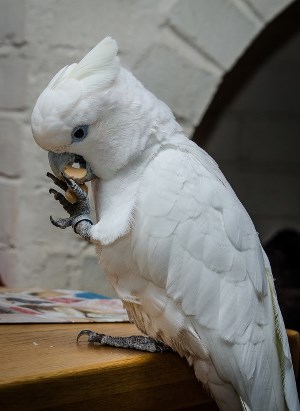Snapas
Pastebėję paukščio negalavimą kuo skubiau kreipkitės į veterinarą. Paukščiai slepia savo ligas ir tuo metu kai ji būna pastebima dažnai būna jau įsisenėjusi ir kritinėje būsenoje.
turbut svarbiausia,kad ataugtu ta vidine kietoji dalis i kuria maistas smulkinasi,nes kitaip visa gyvenima teks ant kosyciu gyvent  bet dabar turbut peraugs apatinis snapas,nes jam nebera i ka trintis....
bet dabar turbut peraugs apatinis snapas,nes jam nebera i ka trintis....
 bet dabar turbut peraugs apatinis snapas,nes jam nebera i ka trintis....
bet dabar turbut peraugs apatinis snapas,nes jam nebera i ka trintis....-

kaukute - Pranešimai: 1310
- Užsiregistravo: 2008.12.10 12:53
- Miestas: KLAIPEDA
- Augintiniai:
-

sailor - Pranešimai: 22581
- Užsiregistravo: 2007.02.21 23:18
- Miestas: Kaimas Airijos vidury
- Augintiniai:
-

kaukute - Pranešimai: 1310
- Užsiregistravo: 2008.12.10 12:53
- Miestas: KLAIPEDA
- Augintiniai:
kaukute, va tau keletas straipsnių, ką daryti. Ir gerai būtų kokiam supratingesniam veterinarui pasirodyti.
Trauma
Trauma to the beak may occur as the result of fighting, chewing on electric cords, hitting the beak while flying or landing, or having the beak trapped between cage bars or other hard surfaces. Injuries may include fractures, punctures, and avulsions (tearing away of the beak). Injuries to the beak often bleed, and the hemorrhage needs to be stopped (usually with electrocautery. DO NOT use silver nitrate sticks - they are toxic to birds). The wounds must be cleaned and antibiotics and antifungals may need to be given. The beak has nerve endings, and pain or the displacement of the beak may make eating difficult or impossible. All birds with beak injuries should be examined by a veterinarian. Acrylics may be used to repair the beak until new tissue replaces it.
http://www.avianweb.com/brokenbeaks.html
http://www.worldwidewounds.com/2003/nov ... art-2.html
http://www.birdchannel.com/media/bird-b ... s.aspx.pdf
http://www.holisticbird.org/pages/cs10.htm
Trauma
Trauma to the beak may occur as the result of fighting, chewing on electric cords, hitting the beak while flying or landing, or having the beak trapped between cage bars or other hard surfaces. Injuries may include fractures, punctures, and avulsions (tearing away of the beak). Injuries to the beak often bleed, and the hemorrhage needs to be stopped (usually with electrocautery. DO NOT use silver nitrate sticks - they are toxic to birds). The wounds must be cleaned and antibiotics and antifungals may need to be given. The beak has nerve endings, and pain or the displacement of the beak may make eating difficult or impossible. All birds with beak injuries should be examined by a veterinarian. Acrylics may be used to repair the beak until new tissue replaces it.
http://www.avianweb.com/brokenbeaks.html
http://www.worldwidewounds.com/2003/nov ... art-2.html
http://www.birdchannel.com/media/bird-b ... s.aspx.pdf
http://www.holisticbird.org/pages/cs10.htm
-

sailor - Pranešimai: 22581
- Užsiregistravo: 2007.02.21 23:18
- Miestas: Kaimas Airijos vidury
- Augintiniai:
-

kaukute - Pranešimai: 1310
- Užsiregistravo: 2008.12.10 12:53
- Miestas: KLAIPEDA
- Augintiniai:
Dabar prisijungę
Vartotojai naršantys šį forumą: Registruotų vartotojų nėra ir 5 svečių




